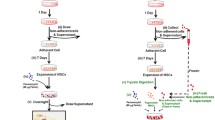ABSTRACT
Purpose
Cell labeling with magnetic nanoparticles can be used to monitor the fate of transplanted cells in vivo by magnetic resonance imaging. However, nanoparticles initially internalized in administered cells might end up in other cells of the host organism. We investigated a mechanism of intercellular cross-transfer of magnetic nanoparticles to different types of recipient cells via cell microvesicles released under cellular stress.
Methods
Three cell types (mesenchymal stem cells, endothelial cells and macrophages) were labeled with 8-nm iron oxide nanoparticles. Then cells underwent starvation stress, during which they produced microvesicles that were subsequently transferred to unlabeled recipient cells.
Results
The analysis of the magnetophoretic mobility of donor cells indicated that magnetic load was partially lost under cell stress. Microvesicles shed by stressed cells participated in the release of magnetic label. Moreover, such microvesicles were uptaken by naïve cells, resulting in cellular redistribution of nanoparticles. Iron load of recipient cells allowed their detection by MRI.
Conclusions
Cell microvesicles released under stress may be disseminated throughout the organism, where they can be uptaken by host cells. The transferred cargo may be sufficient to allow MRI detection of these secondarily labeled cells, leading to misinterpretations of the effectiveness of transplanted cells.








Similar content being viewed by others
Abbreviations
- BMSC:
-
bone marrow stem cells
- FBS:
-
fetal bovine serum
- FISP:
-
fast steady state precession
- FLASH:
-
fast low-angle shot
- HUVEC:
-
human umbilical vascular endothelial cells
- MSC:
-
mesenchymal stem cells
- PMA:
-
phorbol 12-myristate 13-acetate
- SWI:
-
susceptibility weighted imaging
REFERENCES
Rogers WJ, Meyer CH, Kramer CM. Technology insight: in vivo cell tracking by use of MRI. Nat Clin Pract Cardiovasc Med. 2006;3(10):554–62.
Frank JA, Miller BR, Arbab AS, Zywicke HA, Jordan EK, Lewis BK, et al. Clinically applicable labeling of mammalian and stem cells by combining superparamagnetic iron oxides and transfection Agents1. Radiology. 2003;228(2):480–7.
Hinds KA, Hill JM, Shapiro EM, Laukkanen MO, Silva AC, Combs CA, et al. Highly efficient endosomal labeling of progenitor and stem cells with large magnetic particles allows magnetic resonance imaging of single cells. Blood. 2003;102(3):867–72.
Wilhelm C, Gazeau F. Universal cell labelling with anionic magnetic nanoparticles. Biomaterials. 2008;29(22):3161–74.
Terrovitis J, Stuber M, Youssef A, Preece S, Leppo M, Kizana E, et al. Magnetic resonance imaging overestimates ferumoxide-labeled stem cell survival after transplantation in the heart. Circulation. 2008;117(12):1555–62.
Amsalem Y, Mardor Y, Feinberg MS, Landa N, Miller L, Daniels D, et al. Iron-oxide labeling and outcome of transplanted mesenchymal stem cells in the infarcted myocardium. Circulation. 2007;116(11):138–45.
Pap E, Pallinger E, Pasztoi M, Falus A. Highlights of a new type of intercellular communication: microvesicle-based information transfer. Inflamm Res. 2009;58(1):1–8.
Leroyer AS, Tedgui A, Boulanger CM. Role of microparticles in atherothrombosis. J Intern Med. 2008;263(5):528–37.
Chironi GN, Boulanger CM, Simon A, Dignat-George F, Freyssinet JM, Tedgui A. Endothelial microparticles in diseases. Cell Tissue Res. 2009;335(1):143–51.
Luciani N, Wilhelm C, Gazeau F. The role of cell-released microvesicles in the intercellular transfer of magnetic nanoparticles in the monocyte/macrophage system. Biomaterials. 2010;31(27):7061–9.
Wilhelm C, Gazeau F, Bacri JC. Magnetophoresis and ferromagnetic resonance of magnetically labeled cells. Eur Biophys J. 2002;31(2):118–25.
Pawelczyk E, Arbab AS, Chaudhry A, Balakumaran A, Robey PG, Frank JA. In vitro model of bromodeoxyuridine or iron oxide nanoparticle uptake by activated macrophages from labeled stem cells: implications for cellular therapy. Stem Cells. 2008;26(5):1366–75.
Pawelczyk E, Jordan EK, Balakumaran A, Chaudhry A, Gormley N, Smith M, et al. In vivo transfer of intracellular labels from locally implanted bone marrow stromal cells to resident tissue macrophages. PLoS One. 2009;4(8):e6712.
Beyer C, Pisetsky DS. The role of microparticles in the pathogenesis of rheumatic diseases. Nat Rev Rheumatol. 2009;6(1):21–9.
Morel O, Toti F, Hugel B, Freyssinet JM. Cellular microparticles: a disseminated storage pool of bioactive vascular effectors. Curr Opin Hematol. 2004;11(3):156–64.
Valadi H, Ekström K, Bossios A, Sjöstrand M, Lee JJ, Lötvall JO. Exosome-mediated transfer of mRNAs and microRNAs is a novel mechanism of genetic exchange between cells. Nat Cell. 2007;9(6):654–9.
Safaei R, Larson BJ, Cheng TC, Gibson MA, Otani S, Naerdemann W, et al. Abnormal lysosomal trafficking and enhanced exosomal export of cisplatin in drug-resistant human ovarian carcinoma cells. Mol Cancer. 2005;4(10):1595–604.
ACKNOWLEDGMENTS & DISCLOSURES
This work has been supported by the European project Magnifyco (Contract NMP4- SL-2009-228622). The authors thank Gwennhael Autret and Olivier Clément from the Small Animal Imaging Platform Paris – Descartes at the PARCC-HEGP for MRI imaging, Nicole Boggetto from the Flow Cytometry platform ImagoSeine - Institut Jacques Monod for FACS analysis, Christine Longin and Sophie Chat from Mima2 platform- Inra (Jouy en Josas) for TEM analysis and Pierre Emmanuel Rautou and Chantal Boulanger for fruitful discussion. J. Kolosnjaj-Tabi was supported by the European network ENCITE.
Author information
Authors and Affiliations
Corresponding author
Rights and permissions
About this article
Cite this article
Silva, A.K.A., Wilhelm, C., Kolosnjaj-Tabi, J. et al. Cellular Transfer of Magnetic Nanoparticles Via Cell Microvesicles: Impact on Cell Tracking by Magnetic Resonance Imaging. Pharm Res 29, 1392–1403 (2012). https://doi.org/10.1007/s11095-012-0680-1
Received:
Accepted:
Published:
Issue Date:
DOI: https://doi.org/10.1007/s11095-012-0680-1




